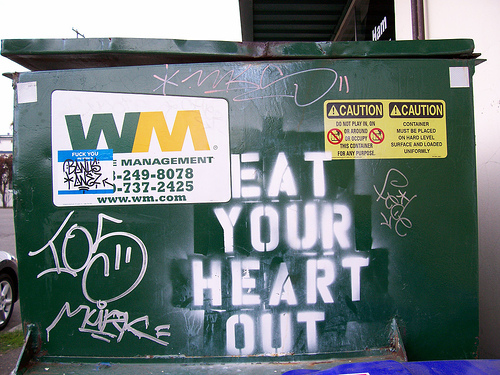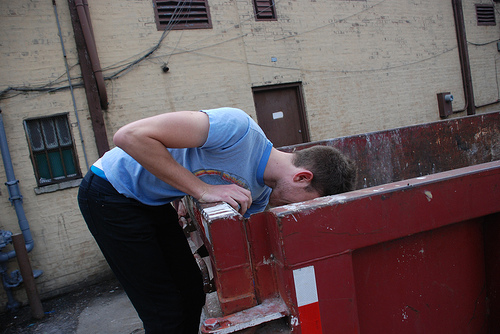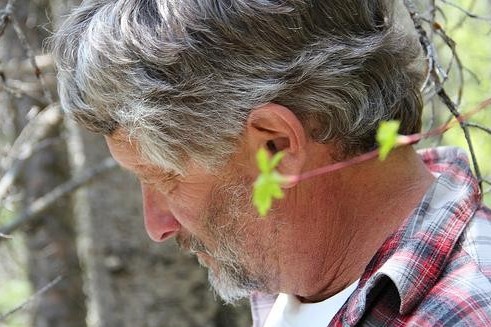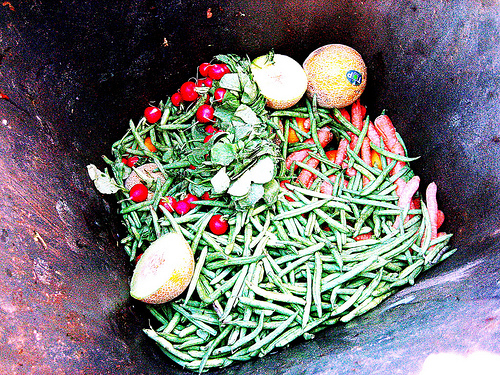 Photo: married to potatoesIt’s after dark in Manhattan, and the Upper West Side neighborhood of Morningside Heights is shutting down. The bagel shops and gourmet groceries, the restaurants and delicatessens, are closed or closing for the night, lights dimmed, iron gates shuttered over storefronts. On the sidewalks, black and translucent trash bags pile up. They are full of day-old salads, fruits, vegetables, bread, premade sandwiches, coffee grounds, receipts, and milk cartons.
Photo: married to potatoesIt’s after dark in Manhattan, and the Upper West Side neighborhood of Morningside Heights is shutting down. The bagel shops and gourmet groceries, the restaurants and delicatessens, are closed or closing for the night, lights dimmed, iron gates shuttered over storefronts. On the sidewalks, black and translucent trash bags pile up. They are full of day-old salads, fruits, vegetables, bread, premade sandwiches, coffee grounds, receipts, and milk cartons.
At 10 p.m., Annie Deng waits in the entrance of a Duane Reade on 110th Street. Her foldable hand cart, the kind used by older women across the city for pushing laundry or groceries, stands in the corner by a coupon rack. She’s flipping through a book of advertisements.
“Look at how much people pay for all this stuff!” she says, lifting the book. “We can get it for free.”
Deng is a freegan, an activist who has chosen to live conscientiously with regard to her impact on people and the planet. Freeganism, as the movement is known, could be defined as an attempt to live off the waste of capitalism — to salvage those consumer goods that are abandoned when they are slightly worn or even untouched. For a freegan, the world is a grocery store, and everything is marked 100 percent off.
The ideas behind the movement are broad, and definitions are open to interpretation. It’s part activism, part lifestyle, part moral imperative. (The freegan movement has roots in Food Not Bombs, a nonprofit organization started in 1980 that takes food that would otherwise by thrown out by grocery stores to food pantries and homeless shelters.) Freegans often embrace waste minimization, eco-friendly transportation, rent-free housing, and working less. Deng, on this particular night, is practicing one of the defining elements of the lifestyle: dumpster diving.
Nationwide, the freegan movement is definitely growing, says Jeff Ferrell, 56. Ferrell, a professor of sociology at Texas Christian University and visiting professor of criminology at the University of Kent in the United Kingdom, is a long-time chronicler of dumpster diving, and a dumpster diver himself.
“As someone who has literally been out there every day, I’m quite confident in saying that the interest in dumpster diving and participating in it is certainly increasing,” he said.
On Meetup.com, the “NYC Freegan” group has over a thousand members. Grocers on the Upper West Side, where Deng often searches for food, say that they’ve seen dumpster divers many nights.
“I thought it was a fad,” said Mark Kirk, a night manager at West Side Market, on Broadway and 110th Street. He’s worked there for four years, and noticed an increase in dumpster diving activity starting last year.
I’ve come to the Upper West Side to meet Deng with another freegan, musician Gio Andollo, 24. They’re going to teach me the art and etiquette of dumpster diving.
As I soon discover, the term “dumpster diving” is not entirely accurate. There aren’t many open dumpsters in the city. “Scavenging” may be a better term for the practice. Deng calls it “rescuing.”
There is certainly enough to go around. The United States generates 34 million tons, or 68 billion pounds, of food waste each year, according to the Environmental Protection Agency. Assuming that the average American eats close to five pounds per day, that’s enough wasted food to feed every single resident of New York City’s five boroughs for five years. It costs taxpayers about a billion dollars to dispose of all that food, a lot of which goes into landfills — where it decomposes to produce methane, a greenhouse gas. A 2004 study by University of Arizona anthropologist Timothy Jones indicates that about half of all the food ready for harvest in the U.S. is never eaten.
Clearly there are problems with waste in America. But can picking through the trash for food actually solve anything? Ferrell said that dumpster diving is an effective means of bringing the issue to light. It demonstrates that reusing and recycling things, even wasted food, can be easy and cost-effective. Dumpster diving, by virtue of being strange, is also self-promoting. People want to know about the people who eat food out of the trash. Freegan activists in New York City, who are organized through a website called Freegan.info, know this. They’ve been featured in media outlets from The New York Times to the Oprah show.
————————————–
 For many, freeganism is a form of activism, not an economic necessity.Photo: incandenzafiedDeng, 23, is short, with straight black hair. She’s earnest and quick to smile. Her family immigrated to the United States from China when she was 6. She is finishing a bachelor’s degree in International Studies at City College. Her definition of freeganism goes like this:
For many, freeganism is a form of activism, not an economic necessity.Photo: incandenzafiedDeng, 23, is short, with straight black hair. She’s earnest and quick to smile. Her family immigrated to the United States from China when she was 6. She is finishing a bachelor’s degree in International Studies at City College. Her definition of freeganism goes like this:
“I think of the verb free,” she says. “Freeing your mind, freeing yourself, freeing everybody from the existing society and system, treadmill, rat race. Plato’s cave. When you’re standing on the outside and looking in on everyone else you think this is strange and bizarre, and it doesn’t make any sense.”
Deng is certainly on the outside. She doesn’t ride the subway — she doesn’t support the MTA, which she says treats its employees badly. Instead she walks everywhere, even going so far as to trek, on rare occasions, from her apartment on 139th Street in Manhattan to Flushing, Queens, 10 miles away, where her extended family lives. She relishes walking as a chance to exercise and people watch.
Deng lives on a mere $550 per month, which goes for rent. She also, interestingly, owns all seven seasons of “Sex and the City” on DVD. But she regards the show almost with an anthropologist’s eye. The show helps her keep in touch with popular culture, she says. And she got the discs free, from Craigslist.
Deng and Andollo are what one might think of as typical freegans: young and idealistic. Andollo, a singer-songwriter, keeps his hair long and unkempt, shoved under a ratty beanie, and his pants are typically full of holes. Dumpster diving and other freegan activities keep his expenses to about $800 per month, which he makes busking and doing odd jobs. Some of his money goes toward causes he cares about, like donating to the homeless and sponsoring a child in Thailand. But Andollo says he isn’t particularly political about his lifestyle.
“For me it isn’t as much about the anti-capitalist thing, like it is for many freegans,” he says. “It’s about wasting less food. I can help by literally taking food off the curbside.”
The last addition to our group on this particular night is different. David George, 63, is an Iraq war vet who met Deng through Freecycle, an internet group that brings people together to trade unwanted goods. George is a kindly man with white hair and a white mustache. Although he was admittedly quite bohemian in his youth, George dumpster dives for practical, not political, reasons. He is jobless, though he receives pension and disability from his service as a reservist. For him, a free meal doesn’t hurt.
Digging in the trash for food seems like an act one would undertake out of desperation. But freegans I’ve interviewed aren’t necessarily desperate, nor are they all poor. Many are middle class people with regular jobs. Others are students like Deng, or artists like
Andollo, or retirees like George. What connects them is a unified disgust with wastefulness, the courage to dig through someone else’s garbage, and a little time. Collecting food can take a few hours a week, and cleaning the food adds more time. All that walking from store to store and squatting to look through bags can be healthy, though. Deng says it’s like exercising while shopping.
Much as joggers need running shoes and tennis players need racquets, dumpster divers have a standard set of equipment. At the very least, you’ve got to have a container to carry the recovered food. Andollo has a handful of canvas grocery bags. Deng has her handcart. George brought the suitcase, as well as a flashlight.
Deng also carries duct tape, just in case a bag gets irreparably ripped. It is freegan custom to leave a site nicer than it was found — just like the Boy Scouts do.
We set out on Broadway for a bagel shop that George says is a good bet. Bagel shops have to throw out their surplus daily, and the food is almost always still fresh.
We stop in front of the store, and the group methodically surveys the pile of six or seven garbage bags on the sidewalk. Andollo grabs a black bag and lifts it off the ground, hefting it up and down, like a shopper testing the weight of a watermelon. You can mostly tell the contents of a bag by weight, he explains. If it’s very light, it’s probably just papers and things. We’re looking for bags with substance.
He squats and squeezes the bags, searching for the shape of bagels before selecting one and untying it. Inside are dozens of bagels, untouched, and separate from other trash. Andollo, Deng and George take what they want before retying the bag and moving on.
The next stop is a small gourmet grocery store called Garden of Eden. The grocery store is more difficult to navigate than the bagel shop — the trash pile is much bigger, 15 bags or more, and there is more food to rummage through. The waste is tossed out indiscriminately, not separated as cleanly as at the first store. The group just has to open bags and rifle through sticky and mysterious refuse. Andollo found a bunch of onions buried under discarded lettuce, newspapers, coupons, and other bits of trash.
In this case, it’s up to the diver to discern whether or not the food is possibly contaminated. A significant number of freegans I’ve spoken to are vegetarians, as is Andollo. Food poisoning from rotten meat isn’t a problem for him. He inspects the vegetables, and as long as they’re not clearly dirty, he sticks them in his bag.
Meanwhile Deng, at the other end of the pile, has discovered an almost perfect bag. It is full of prepackaged gourmet platters and sandwiches, and there is no other garbage polluting it. She names each item as she pulls it out, offering it to the others.
“Anyone want a Cuban panini? Egg salad sandwich? Prosciutto?”
She adds the sandwiches to the other things she’s found — a grilled salmon meal with two sides and a beet salad.
“Freegans have a diverse diet because they get to try so many different things,” she says.
Andollo became a freegan in December of 2009, when he joined the Freegan.info group. He’d always been conscious of waste, but after moving to New York from Florida and trying to make it as a musician, becoming a freegan was as much a monetary decision as an ethical one.
He has fully embraced the dumpster diving lifestyle. It means a saving of about $50 on groceries a week, he figures. Coupled with his living situation — five people in a two-bedroom apartment in Harlem — the savings mean his artistic lifestyle is quite sustainable.
We continue south on Broadway, heading to another grocery that George knows. On the way, Deng stops to inspect some trash in front of a Walgreens. Beside the store a homeless man in leather is sitting on his suitcase. He watches as Deng breaks open a bag and sifts through its contents.
She soon pulls out some treasures: Nail polish remover, some packages of lip balm, and a heart-shaped plush pillow.
Andollo immediately reaches for the lip balm. The homeless man shuffles over, curiously inspecting the containers Andollo is clutching.
“I’ll trade you for that,” the man mutters indistinctly.
“What?” asks Andollo.
“I’ll trade you for it,” the man repeats, louder, but not forcefully.
Andollo hesitates for a moment.
Deng pulls out some more lip balm, and Andollo relents.
“Here,” he says, offering the man his packages. “You can have them.”
The man thanks him, and drags his suitcase off.
Deng pulls out her duct tape to repair the damaged bag.
————————————–
When I see Deng a few days after our Upper West Side scavenge, she’s wearing a large-brimmed brown hat that looks like a dainty version of Indiana Jones’s fedora over blue-and-purple plaid Burberry earmuffs. The hat, she says, came from a glittery pink hatbox she found a few years ago on the side of the road. The earmuffs she discovered on the sidewalk this winter after returning home from watching a lunar eclipse. Her canvas bag, which says Campus Progress, was free from a student activist group she’s part of. Inside the bag there is chalk, for her part-time job teaching English, a book she found called Happiness and the Economy, and an apple strudel a friend had given her instead of throwing out.
“Did you hear about what else we found the other night?” she asks.
I tell her no.
It turns out the big find of the night was an air mattress, which looked as if it had been returned to Walgreens and was incorrectly stuffed back into its box. Andollo took it home to see if it was functional.
“Did you eat that curry chicken sandwich?” she asks.
I’d taken a fully packaged sandwich from the Garden of Eden. It seemed harmless, and I was curious.
“I gave it to a homeless man,” I say.
It was a lie. I immediately felt bad — first for wasting food, again, and second for lying about not wasting food. It wasn’t entirely untrue. I’d tried to give the sandwich to a man begging on the train, but he said he didn’t accept food. Someone tried to poison him once, he said. When I got home I saw the sandwich had expired the day before. And I don’t do well with curry. Worth the risk? I didn’t know. I threw it back in the trash.
Deng takes the apple strudel from her bag. The friend who gave her the dessert had thought twice before throwing it out. When you set an example, other people are compelled to be less wasteful, she says.
She offers me the strudel, and I accept. This time I’m determined not to waste the food.
I eat it two hours later. It’s stale.
————————————–
 Waste not, want not.Photo: narnuaOne of the main events of the New York freegan community is the Freegan Feast, a monthly event that starts with a dumpster-diving session and ends with a dinner the next day at a freegan volunteer’s house.
Waste not, want not.Photo: narnuaOne of the main events of the New York freegan community is the Freegan Feast, a monthly event that starts with a dumpster-diving session and ends with a dinner the next day at a freegan volunteer’s house.
I had to try it.
A group of about 17 people gather on 3rd Avenue between 38th and 39th street in front of a D’Agostino grocery store, where several black trash bags have been left on the sidewalk.
Many in the group are established freegans who have come to support the group and teach the newcomers the trade. But in every session there are a few new people eager to learn.
There are three main rules for a trash tour:
- Don’t rip the bags.
- Cooperate and share.
- Everyone must participate.
Once the rules are explained, the group circles and picks at the trash heap l
ike vultures on a carcass. They open bags and fish out anything that looks like it might be good for the feast the next day.
Jared Schwartz, 24, is new to freeganism. He just moved to New York from Ottawa, Canada, to look for a job in landscape architecture. I ask Schwartz why he decided to come tonight. He says that he is disgusted by the amount of food that is wasted, but he wouldn’t consider himself an activist at all.
“I guess I’m an anti-waste kind of person,” he says.
As I’m speaking to him, an elderly woman with a cane hobbles over to us.
“What are you doing?” she asks.
“We’re… taking food out of the trash,” Schwartz says, somewhat uneasily.
“Well,” replies the woman. “I guess some people have to.”
For some on this tour, one of the biggest hurdles they face isn’t the gross-out factor of taking food from the trash. It’s not police harassment, which is a factor in other parts of the country, where trash sits in dumpsters on private property rather than on the public sidewalk.
No, the big problem can be the public’s perception of people taking food out of the trash. During the tour, for example, a group of teenagers working the late shift at the D’Agostinos are standing at the window, laughing and taking pictures of the freegans with their cell phones.
“I was always kind of skittish about opening bags, but I guess people do it,” Schwartz says. He’s comforted that many of the people are middle class, like him.
Jeff Ferrell said that the biggest obstacle people confront is “renegotiating who they are,” once they start dumpster diving. There is a stigma, and it takes some time to get past that. But Ferrell says that once a dumpster diver has come to terms with it, a “reverse stigma” may emerge. Like Deng said before, “We can get it for free.” Why spend $5 on a smoothie, when you can make one out of fruits you find?
Schwartz says that in Europe he saw lots of people taking food from the trash. When he moved to New York, he was walking uptown and saw a garbage can full of grapefruits in front of a grocery store. Because he loves grapefruit, he decided to take a few. The man who was taking out the trash told him, “Go get a bag. It’s garbage for these people.”
So Schwartz walked inside, grabbed a bag, and walked away with a bunch of grapefruits, avocados, and strawberries that the man was throwing out.
Gokalp Soygul, a manager at the Garden of Eden grocery store that Deng, Andollo, and George visited on the Upper West Side, said that he doesn’t mind the dumpster divers. Six to 10 divers arrive each night, usually looking for the prepackaged, expired sandwiches and fruits. Garden of Eden even claims to separate its food items in the trash to help the scavengers, who Soygul said are just “regular people, like you and me.”
“They don’t ask us nothing, we don’t bother them, and they can go ahead and do whatever they like,” he said.
Soygul doesn’t look down on the practice, and he doesn’t suspect that the dumpster divers need to save money by getting free food. He thinks they just don’t want to see the food wasted.
“I would do the same thing if I had something close to my apartment,” he said. “Why not?”
Another grocer, Dominic Galofaro, a manager at Milano Market a few blocks away, doesn’t mind the freegans either.
“It’s going to be picked up anyway,” he said. “As long as they’re not throwing it around, it’s fine. … I’ll tell you the God honest truth. The food that goes in there is pretty good.”
————————————–
The freegan feast is at Susan Hirsch’s apartment in Park Slope, Brooklyn. Hirsch, 41, is a bubbly psychologist who works at a community clinic in the Bronx. She has been part of the Freegan.info group for two years. She said that she spends less than $10 a week on food. She says she believes in the political aspect of freeganism, but that she’s also self-interested.
“I like to get things for free,” she says.
Her one-bedroom apartment is small, but full of books and sheet music. There is a piano in the living room.
In the living room, Natalia Cruz, a UniVision broadcast reporter, gets ready for the feast. She has come to wrap up a television story that started with the trash tour the night before. Her cameraman asks Hirsch to play the piano, perhaps to show the audience that she leads a fairly normal life. The freegans are used to this kind of media attention. It’s a good way to showcase their cause.
The apartment is filled with women. Nine people in total show up, although 20 RSVPed on the Meetup.com group. There is only one man. None of the newcomers to the tour last night come. In the kitchen, the women pass around ingredients for the main dishes. The meal will be vegan-friendly, since some of the participants are vegan or vegetarian.
There’s broccoli, tomato, onion, kale, squash, carrots, pasta, artificial pork, and a mysterious something that resembles rice. A vegan piecrust found last night will be stuffed with strawberries and put in the oven for dessert. For appetizers there is a bowl of purple grapes, a bag of Doritos, a tray of old Christmas cookies, and a few prepackaged carrot snacks with ranch dip.
Cruz sits patiently in the living room as the women work. She picks at a few grapes at the insistence of the freegans, but doesn’t eat any other appetizers. She’d just eaten a big steak dinner she explains, to the chagrin of some of the vegans.
Once the ingredients are together the women get to work. After some deliberation, they decide what they will make: a broccoli-based stir fry, pasta with the artificial meat, and a dish with vegetables and the mystery rice.
After some preparation, some of the dishes are brought out to the living room and set ceremoniously on a small table. The UniVision cameraman sets up a shot focusing on Cruz and the food. She gets to try the first bite. After delivering a short introduction to the camera, she takes a scoop of the stir fry in a spoon and lifts it up. The freegans in the living room wait to see her reaction. She sticks the spoon in her mouth, swallows and smiles. Then she says in Spanish, “It’s better not to think about where it comes from, but to taste it.”



